Analysis of British Airways: Business Intelligence Report
VerifiedAdded on 2020/05/28
|7
|1554
|49
Report
AI Summary
This report examines the application of business intelligence (BI) within British Airways. It begins with an introduction to BI and its significance, followed by an overview of British Airways' background. The report identifies key problems faced by the airline, particularly in decision-making, including financial challenges, changing work practices, and mergers. It then details the organizational responses to these problems, such as staff requests and merger agreements, and analyzes the quantitative and qualitative impacts of these responses on managerial decision-making. Furthermore, the report explores how BI can be leveraged to support problem-solving and decision support within British Airways, including enhancing ticket management, analyzing consumer behavior, and improving operational efficiency through data analysis. The report concludes with a list of references used in the analysis.
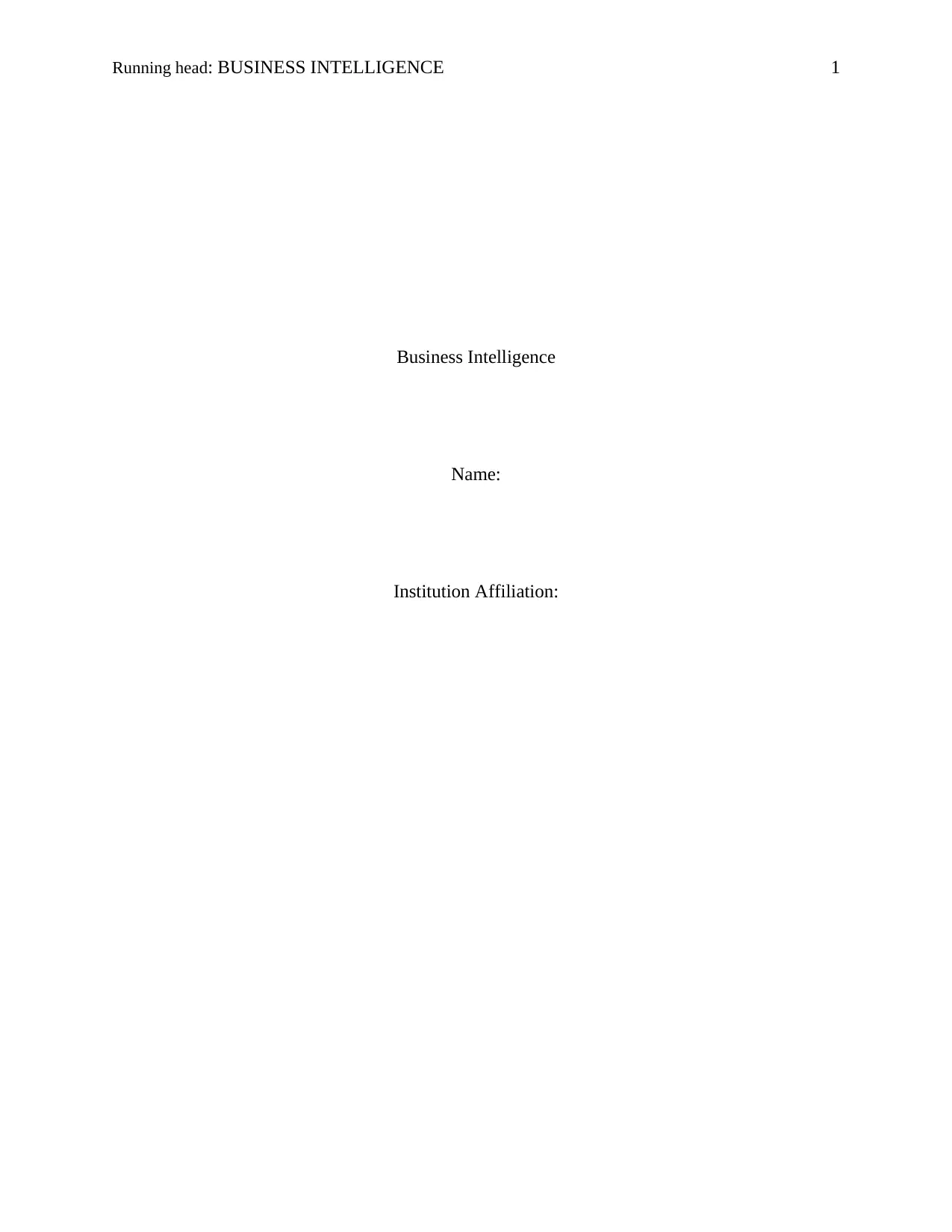
Running head: BUSINESS INTELLIGENCE 1
Business Intelligence
Name:
Institution Affiliation:
Business Intelligence
Name:
Institution Affiliation:
Paraphrase This Document
Need a fresh take? Get an instant paraphrase of this document with our AI Paraphraser
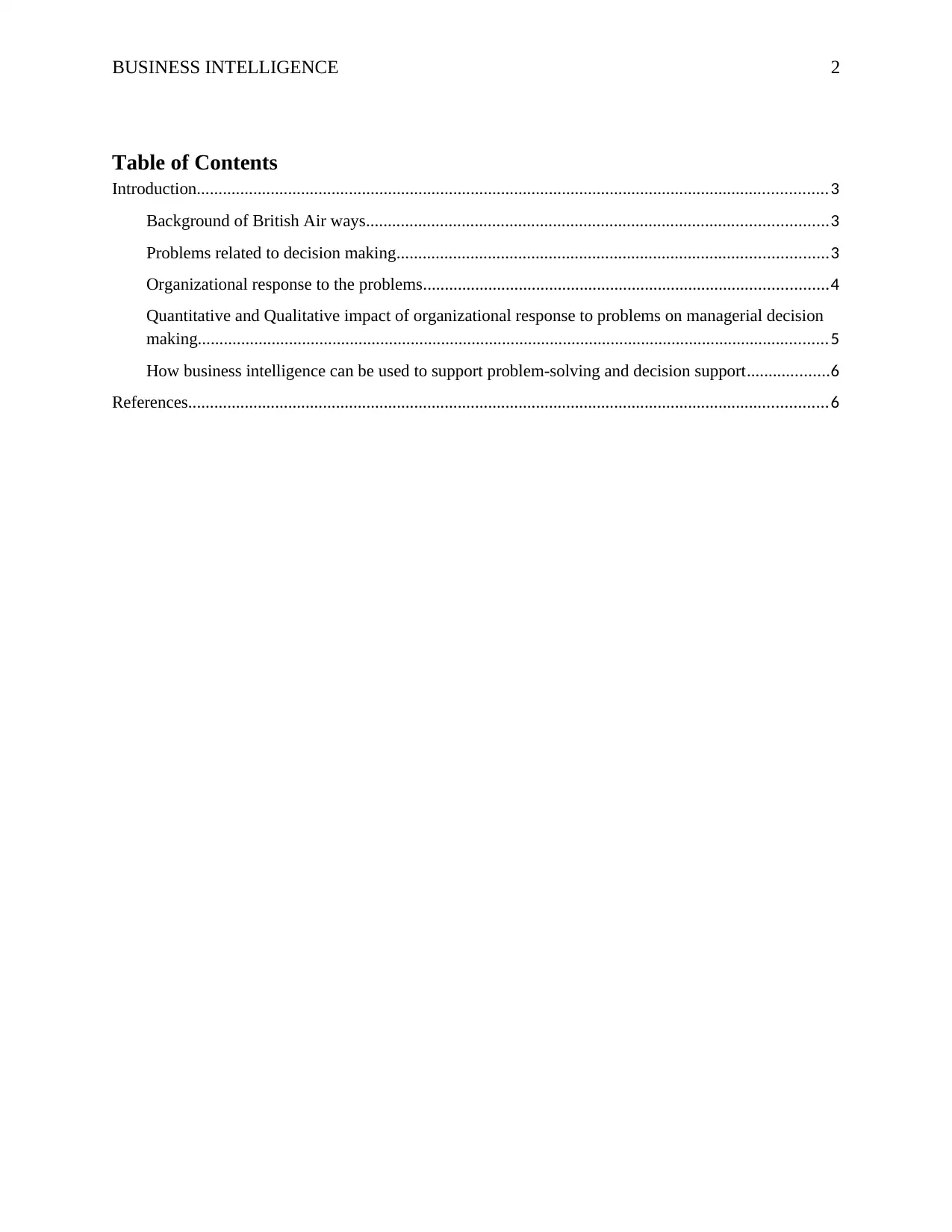
BUSINESS INTELLIGENCE 2
Table of Contents
Introduction.................................................................................................................................................3
Background of British Air ways..........................................................................................................3
Problems related to decision making...................................................................................................3
Organizational response to the problems.............................................................................................4
Quantitative and Qualitative impact of organizational response to problems on managerial decision
making.................................................................................................................................................5
How business intelligence can be used to support problem-solving and decision support...................6
References...................................................................................................................................................6
Table of Contents
Introduction.................................................................................................................................................3
Background of British Air ways..........................................................................................................3
Problems related to decision making...................................................................................................3
Organizational response to the problems.............................................................................................4
Quantitative and Qualitative impact of organizational response to problems on managerial decision
making.................................................................................................................................................5
How business intelligence can be used to support problem-solving and decision support...................6
References...................................................................................................................................................6
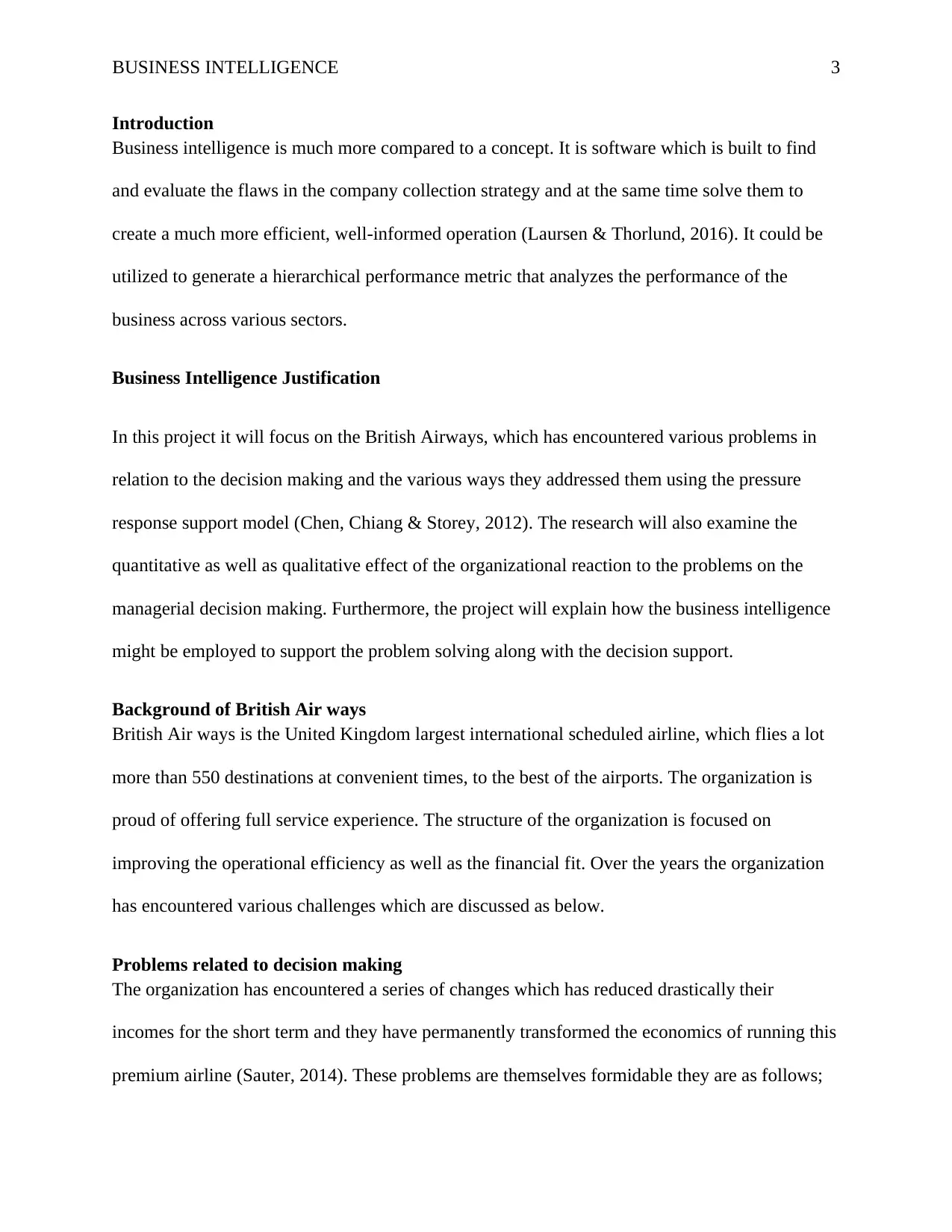
BUSINESS INTELLIGENCE 3
Introduction
Business intelligence is much more compared to a concept. It is software which is built to find
and evaluate the flaws in the company collection strategy and at the same time solve them to
create a much more efficient, well-informed operation (Laursen & Thorlund, 2016). It could be
utilized to generate a hierarchical performance metric that analyzes the performance of the
business across various sectors.
Business Intelligence Justification
In this project it will focus on the British Airways, which has encountered various problems in
relation to the decision making and the various ways they addressed them using the pressure
response support model (Chen, Chiang & Storey, 2012). The research will also examine the
quantitative as well as qualitative effect of the organizational reaction to the problems on the
managerial decision making. Furthermore, the project will explain how the business intelligence
might be employed to support the problem solving along with the decision support.
Background of British Air ways
British Air ways is the United Kingdom largest international scheduled airline, which flies a lot
more than 550 destinations at convenient times, to the best of the airports. The organization is
proud of offering full service experience. The structure of the organization is focused on
improving the operational efficiency as well as the financial fit. Over the years the organization
has encountered various challenges which are discussed as below.
Problems related to decision making
The organization has encountered a series of changes which has reduced drastically their
incomes for the short term and they have permanently transformed the economics of running this
premium airline (Sauter, 2014). These problems are themselves formidable they are as follows;
Introduction
Business intelligence is much more compared to a concept. It is software which is built to find
and evaluate the flaws in the company collection strategy and at the same time solve them to
create a much more efficient, well-informed operation (Laursen & Thorlund, 2016). It could be
utilized to generate a hierarchical performance metric that analyzes the performance of the
business across various sectors.
Business Intelligence Justification
In this project it will focus on the British Airways, which has encountered various problems in
relation to the decision making and the various ways they addressed them using the pressure
response support model (Chen, Chiang & Storey, 2012). The research will also examine the
quantitative as well as qualitative effect of the organizational reaction to the problems on the
managerial decision making. Furthermore, the project will explain how the business intelligence
might be employed to support the problem solving along with the decision support.
Background of British Air ways
British Air ways is the United Kingdom largest international scheduled airline, which flies a lot
more than 550 destinations at convenient times, to the best of the airports. The organization is
proud of offering full service experience. The structure of the organization is focused on
improving the operational efficiency as well as the financial fit. Over the years the organization
has encountered various challenges which are discussed as below.
Problems related to decision making
The organization has encountered a series of changes which has reduced drastically their
incomes for the short term and they have permanently transformed the economics of running this
premium airline (Sauter, 2014). These problems are themselves formidable they are as follows;
⊘ This is a preview!⊘
Do you want full access?
Subscribe today to unlock all pages.

Trusted by 1+ million students worldwide
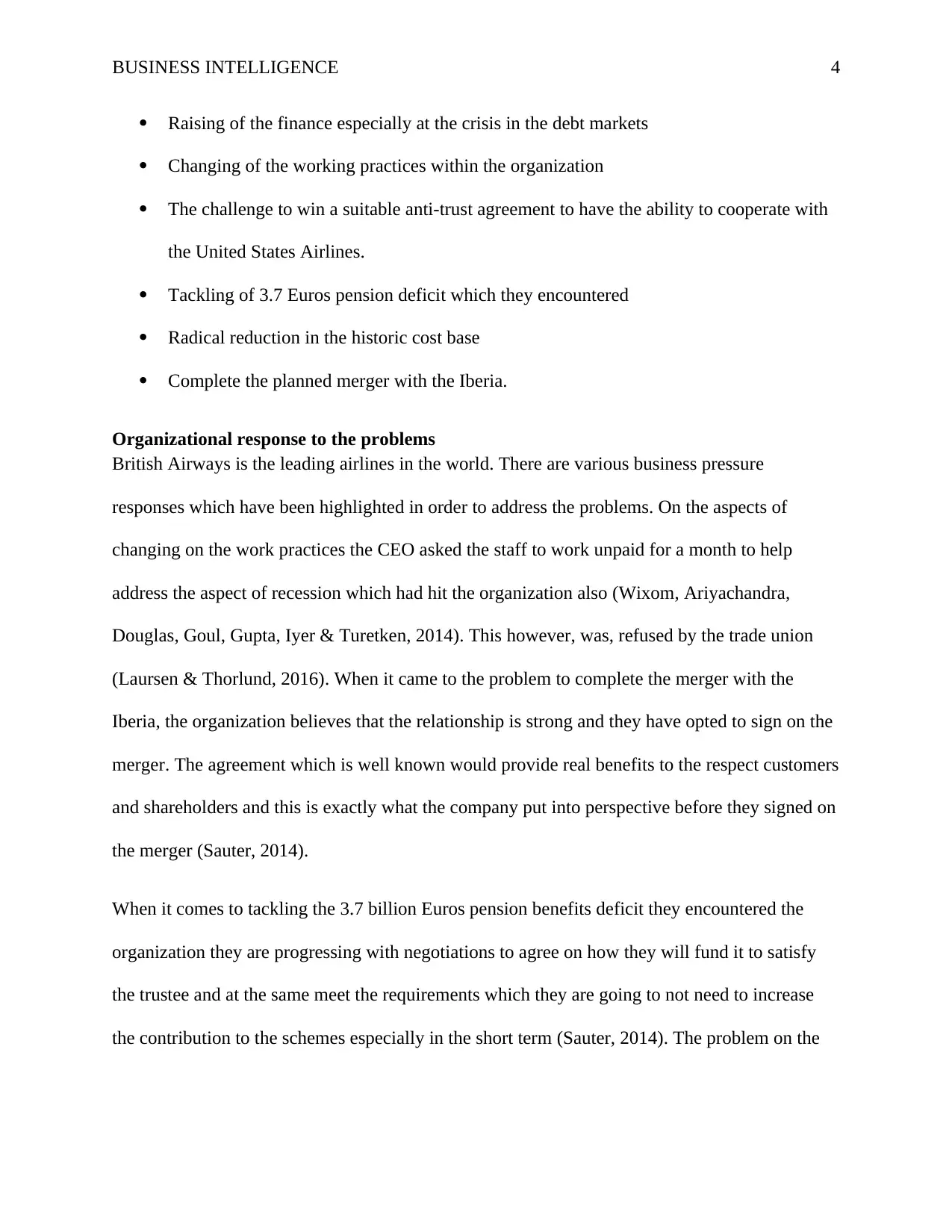
BUSINESS INTELLIGENCE 4
Raising of the finance especially at the crisis in the debt markets
Changing of the working practices within the organization
The challenge to win a suitable anti-trust agreement to have the ability to cooperate with
the United States Airlines.
Tackling of 3.7 Euros pension deficit which they encountered
Radical reduction in the historic cost base
Complete the planned merger with the Iberia.
Organizational response to the problems
British Airways is the leading airlines in the world. There are various business pressure
responses which have been highlighted in order to address the problems. On the aspects of
changing on the work practices the CEO asked the staff to work unpaid for a month to help
address the aspect of recession which had hit the organization also (Wixom, Ariyachandra,
Douglas, Goul, Gupta, Iyer & Turetken, 2014). This however, was, refused by the trade union
(Laursen & Thorlund, 2016). When it came to the problem to complete the merger with the
Iberia, the organization believes that the relationship is strong and they have opted to sign on the
merger. The agreement which is well known would provide real benefits to the respect customers
and shareholders and this is exactly what the company put into perspective before they signed on
the merger (Sauter, 2014).
When it comes to tackling the 3.7 billion Euros pension benefits deficit they encountered the
organization they are progressing with negotiations to agree on how they will fund it to satisfy
the trustee and at the same meet the requirements which they are going to not need to increase
the contribution to the schemes especially in the short term (Sauter, 2014). The problem on the
Raising of the finance especially at the crisis in the debt markets
Changing of the working practices within the organization
The challenge to win a suitable anti-trust agreement to have the ability to cooperate with
the United States Airlines.
Tackling of 3.7 Euros pension deficit which they encountered
Radical reduction in the historic cost base
Complete the planned merger with the Iberia.
Organizational response to the problems
British Airways is the leading airlines in the world. There are various business pressure
responses which have been highlighted in order to address the problems. On the aspects of
changing on the work practices the CEO asked the staff to work unpaid for a month to help
address the aspect of recession which had hit the organization also (Wixom, Ariyachandra,
Douglas, Goul, Gupta, Iyer & Turetken, 2014). This however, was, refused by the trade union
(Laursen & Thorlund, 2016). When it came to the problem to complete the merger with the
Iberia, the organization believes that the relationship is strong and they have opted to sign on the
merger. The agreement which is well known would provide real benefits to the respect customers
and shareholders and this is exactly what the company put into perspective before they signed on
the merger (Sauter, 2014).
When it comes to tackling the 3.7 billion Euros pension benefits deficit they encountered the
organization they are progressing with negotiations to agree on how they will fund it to satisfy
the trustee and at the same meet the requirements which they are going to not need to increase
the contribution to the schemes especially in the short term (Sauter, 2014). The problem on the
Paraphrase This Document
Need a fresh take? Get an instant paraphrase of this document with our AI Paraphraser
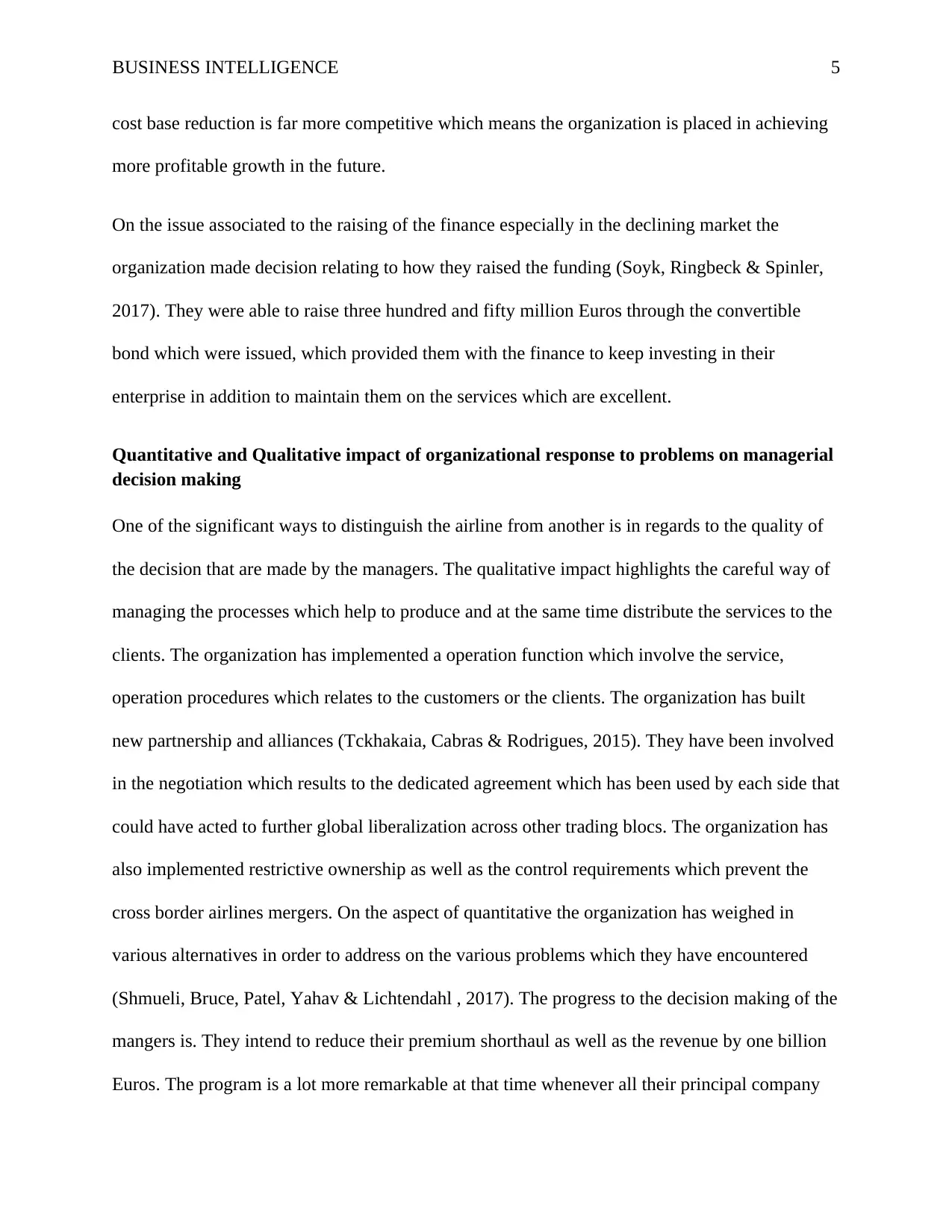
BUSINESS INTELLIGENCE 5
cost base reduction is far more competitive which means the organization is placed in achieving
more profitable growth in the future.
On the issue associated to the raising of the finance especially in the declining market the
organization made decision relating to how they raised the funding (Soyk, Ringbeck & Spinler,
2017). They were able to raise three hundred and fifty million Euros through the convertible
bond which were issued, which provided them with the finance to keep investing in their
enterprise in addition to maintain them on the services which are excellent.
Quantitative and Qualitative impact of organizational response to problems on managerial
decision making
One of the significant ways to distinguish the airline from another is in regards to the quality of
the decision that are made by the managers. The qualitative impact highlights the careful way of
managing the processes which help to produce and at the same time distribute the services to the
clients. The organization has implemented a operation function which involve the service,
operation procedures which relates to the customers or the clients. The organization has built
new partnership and alliances (Tckhakaia, Cabras & Rodrigues, 2015). They have been involved
in the negotiation which results to the dedicated agreement which has been used by each side that
could have acted to further global liberalization across other trading blocs. The organization has
also implemented restrictive ownership as well as the control requirements which prevent the
cross border airlines mergers. On the aspect of quantitative the organization has weighed in
various alternatives in order to address on the various problems which they have encountered
(Shmueli, Bruce, Patel, Yahav & Lichtendahl , 2017). The progress to the decision making of the
mangers is. They intend to reduce their premium shorthaul as well as the revenue by one billion
Euros. The program is a lot more remarkable at that time whenever all their principal company
cost base reduction is far more competitive which means the organization is placed in achieving
more profitable growth in the future.
On the issue associated to the raising of the finance especially in the declining market the
organization made decision relating to how they raised the funding (Soyk, Ringbeck & Spinler,
2017). They were able to raise three hundred and fifty million Euros through the convertible
bond which were issued, which provided them with the finance to keep investing in their
enterprise in addition to maintain them on the services which are excellent.
Quantitative and Qualitative impact of organizational response to problems on managerial
decision making
One of the significant ways to distinguish the airline from another is in regards to the quality of
the decision that are made by the managers. The qualitative impact highlights the careful way of
managing the processes which help to produce and at the same time distribute the services to the
clients. The organization has implemented a operation function which involve the service,
operation procedures which relates to the customers or the clients. The organization has built
new partnership and alliances (Tckhakaia, Cabras & Rodrigues, 2015). They have been involved
in the negotiation which results to the dedicated agreement which has been used by each side that
could have acted to further global liberalization across other trading blocs. The organization has
also implemented restrictive ownership as well as the control requirements which prevent the
cross border airlines mergers. On the aspect of quantitative the organization has weighed in
various alternatives in order to address on the various problems which they have encountered
(Shmueli, Bruce, Patel, Yahav & Lichtendahl , 2017). The progress to the decision making of the
mangers is. They intend to reduce their premium shorthaul as well as the revenue by one billion
Euros. The program is a lot more remarkable at that time whenever all their principal company
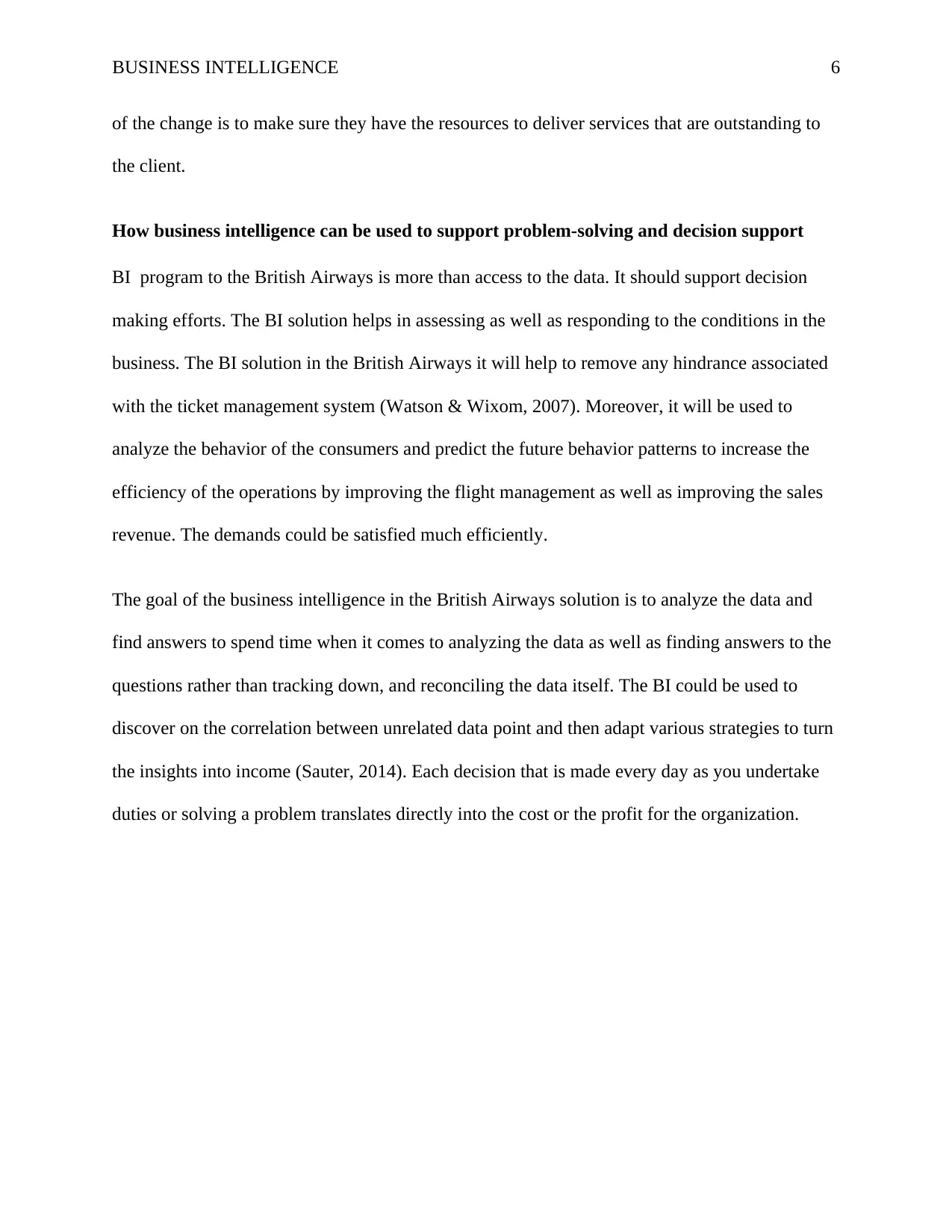
BUSINESS INTELLIGENCE 6
of the change is to make sure they have the resources to deliver services that are outstanding to
the client.
How business intelligence can be used to support problem-solving and decision support
BI program to the British Airways is more than access to the data. It should support decision
making efforts. The BI solution helps in assessing as well as responding to the conditions in the
business. The BI solution in the British Airways it will help to remove any hindrance associated
with the ticket management system (Watson & Wixom, 2007). Moreover, it will be used to
analyze the behavior of the consumers and predict the future behavior patterns to increase the
efficiency of the operations by improving the flight management as well as improving the sales
revenue. The demands could be satisfied much efficiently.
The goal of the business intelligence in the British Airways solution is to analyze the data and
find answers to spend time when it comes to analyzing the data as well as finding answers to the
questions rather than tracking down, and reconciling the data itself. The BI could be used to
discover on the correlation between unrelated data point and then adapt various strategies to turn
the insights into income (Sauter, 2014). Each decision that is made every day as you undertake
duties or solving a problem translates directly into the cost or the profit for the organization.
of the change is to make sure they have the resources to deliver services that are outstanding to
the client.
How business intelligence can be used to support problem-solving and decision support
BI program to the British Airways is more than access to the data. It should support decision
making efforts. The BI solution helps in assessing as well as responding to the conditions in the
business. The BI solution in the British Airways it will help to remove any hindrance associated
with the ticket management system (Watson & Wixom, 2007). Moreover, it will be used to
analyze the behavior of the consumers and predict the future behavior patterns to increase the
efficiency of the operations by improving the flight management as well as improving the sales
revenue. The demands could be satisfied much efficiently.
The goal of the business intelligence in the British Airways solution is to analyze the data and
find answers to spend time when it comes to analyzing the data as well as finding answers to the
questions rather than tracking down, and reconciling the data itself. The BI could be used to
discover on the correlation between unrelated data point and then adapt various strategies to turn
the insights into income (Sauter, 2014). Each decision that is made every day as you undertake
duties or solving a problem translates directly into the cost or the profit for the organization.
⊘ This is a preview!⊘
Do you want full access?
Subscribe today to unlock all pages.

Trusted by 1+ million students worldwide
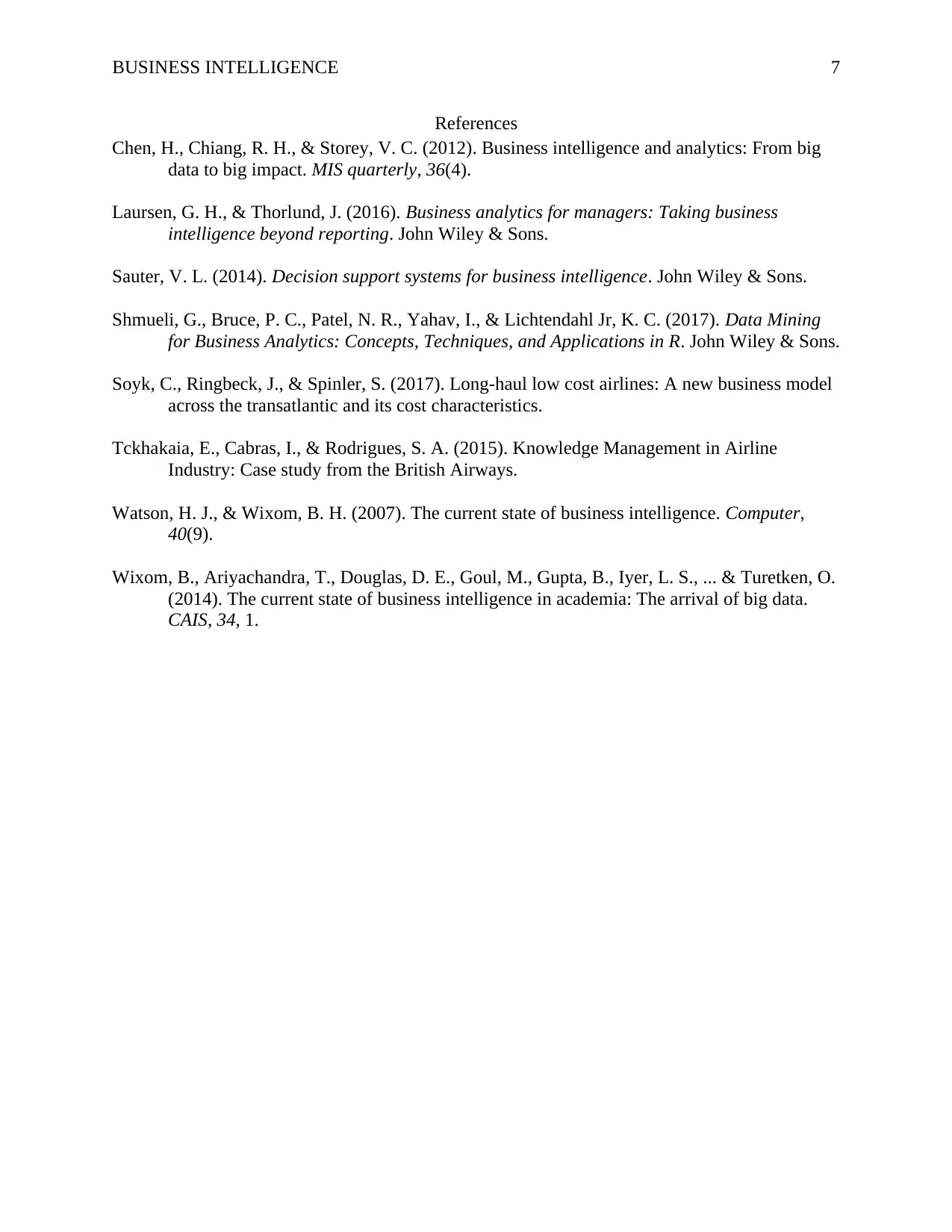
BUSINESS INTELLIGENCE 7
References
Chen, H., Chiang, R. H., & Storey, V. C. (2012). Business intelligence and analytics: From big
data to big impact. MIS quarterly, 36(4).
Laursen, G. H., & Thorlund, J. (2016). Business analytics for managers: Taking business
intelligence beyond reporting. John Wiley & Sons.
Sauter, V. L. (2014). Decision support systems for business intelligence. John Wiley & Sons.
Shmueli, G., Bruce, P. C., Patel, N. R., Yahav, I., & Lichtendahl Jr, K. C. (2017). Data Mining
for Business Analytics: Concepts, Techniques, and Applications in R. John Wiley & Sons.
Soyk, C., Ringbeck, J., & Spinler, S. (2017). Long-haul low cost airlines: A new business model
across the transatlantic and its cost characteristics.
Tckhakaia, E., Cabras, I., & Rodrigues, S. A. (2015). Knowledge Management in Airline
Industry: Case study from the British Airways.
Watson, H. J., & Wixom, B. H. (2007). The current state of business intelligence. Computer,
40(9).
Wixom, B., Ariyachandra, T., Douglas, D. E., Goul, M., Gupta, B., Iyer, L. S., ... & Turetken, O.
(2014). The current state of business intelligence in academia: The arrival of big data.
CAIS, 34, 1.
References
Chen, H., Chiang, R. H., & Storey, V. C. (2012). Business intelligence and analytics: From big
data to big impact. MIS quarterly, 36(4).
Laursen, G. H., & Thorlund, J. (2016). Business analytics for managers: Taking business
intelligence beyond reporting. John Wiley & Sons.
Sauter, V. L. (2014). Decision support systems for business intelligence. John Wiley & Sons.
Shmueli, G., Bruce, P. C., Patel, N. R., Yahav, I., & Lichtendahl Jr, K. C. (2017). Data Mining
for Business Analytics: Concepts, Techniques, and Applications in R. John Wiley & Sons.
Soyk, C., Ringbeck, J., & Spinler, S. (2017). Long-haul low cost airlines: A new business model
across the transatlantic and its cost characteristics.
Tckhakaia, E., Cabras, I., & Rodrigues, S. A. (2015). Knowledge Management in Airline
Industry: Case study from the British Airways.
Watson, H. J., & Wixom, B. H. (2007). The current state of business intelligence. Computer,
40(9).
Wixom, B., Ariyachandra, T., Douglas, D. E., Goul, M., Gupta, B., Iyer, L. S., ... & Turetken, O.
(2014). The current state of business intelligence in academia: The arrival of big data.
CAIS, 34, 1.
1 out of 7
Related Documents
Your All-in-One AI-Powered Toolkit for Academic Success.
+13062052269
info@desklib.com
Available 24*7 on WhatsApp / Email
![[object Object]](/_next/static/media/star-bottom.7253800d.svg)
Unlock your academic potential
Copyright © 2020–2025 A2Z Services. All Rights Reserved. Developed and managed by ZUCOL.





